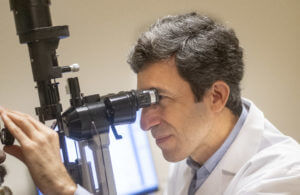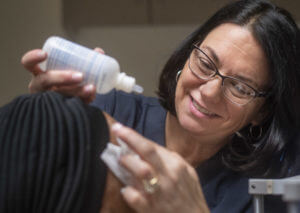Glaucoma Eye Exam - What to Expect
Visual acuity, microscopic eye exam, eye presssure, and more.
Call Us: 215-928-3197
Visual acuity, microscopic eye exam, eye presssure, and more.
Call Us: 215-928-3197
IMPORTANT
It is very important to request your medical records from your prior and/or current eye doctors and confirm that they have been received prior to your first appointment (or better yet, bring the records with you). These records should ideally include prior eye pressures, maximum eye pressures, prior surgery or laser procedures, prior testing (visual field, disc photos, or optical coherence tomography (OCT).
A technician will bring you into the exam room and will ask questions about your eye history, as well as any troubles you are having. You will be asked about:
 Visual Acuity. This checks your vision in the center, which is different from visual field testing (which also tests your peripheral vision). You will be asked to look out of your right eye first then left with your current glasses or contacts. If needed, pinholes will be put in front of the tested eye and you will be asked if this improves the vision.
Visual Acuity. This checks your vision in the center, which is different from visual field testing (which also tests your peripheral vision). You will be asked to look out of your right eye first then left with your current glasses or contacts. If needed, pinholes will be put in front of the tested eye and you will be asked if this improves the vision.
Microscopic Eye Examination. Your ophthalmologist will use a specific microscope to examine the front part of the eye (the cornea, lens, and the colored part of the eye called the iris), and the back part of your eye (your optic nerve and retina).
Checking Eye Pressure. Normal eye pressure ranges between 10-21 mmHg in most patients, and it could be measured with different devices. Eye pressure is unique to each person. Some patients may have glaucoma with an eye pressure less than 21 mmHg. Eye pressure more than 21 mmHg does not mean that you have glaucoma if other tests are within normal limits.
Gonisocopy (checking the drainage system). The drainage system is located where the colored part of the eye (iris) meets the cornea (the very front layer of the eye). The doctor uses a special lens to view the drainage system to determine if it is closed or open. In the closed type, the iris is very close to the cornea and covers the drainage channel. In the open type, the colored part is not close to the cornea and the drainage system is visible. This test helps differentiate between the two major types of glaucoma or glaucoma suspects: open angle and closed angle.

Dilated Eye Examination. Special drops may be used to temporarily enlarge the pupil so that your doctor can better view the back part of your eyes (retina and optic nerve).
Dilation drops take approximately 15-20 minutes to take effect.
They can last a few hours and may cause some light sensitivity and your vision to be more blurry (especially up close) during that time.
For more general information regarding planning your visit to Wills Eye Hospital, refer to our Plan Your Visit page.
